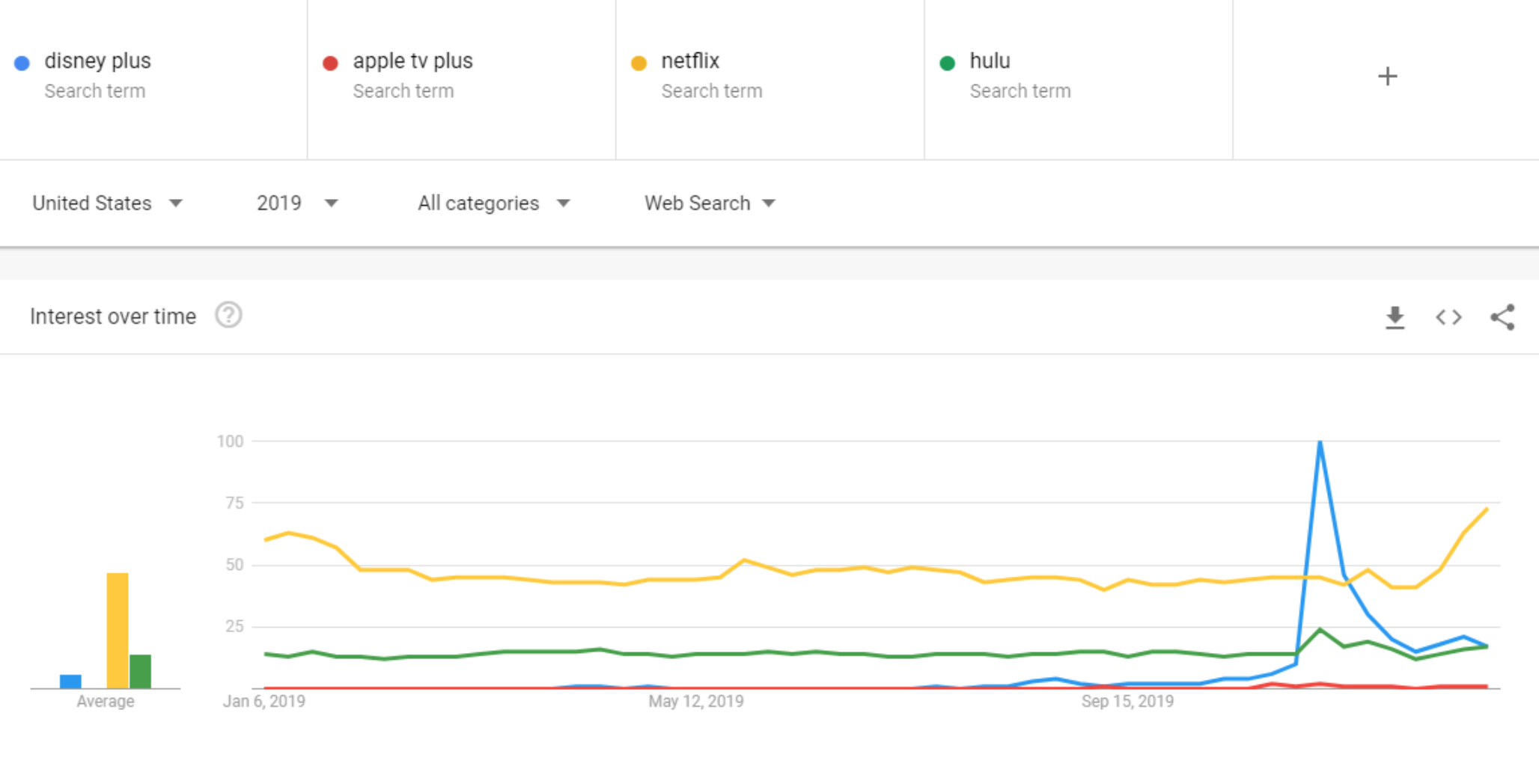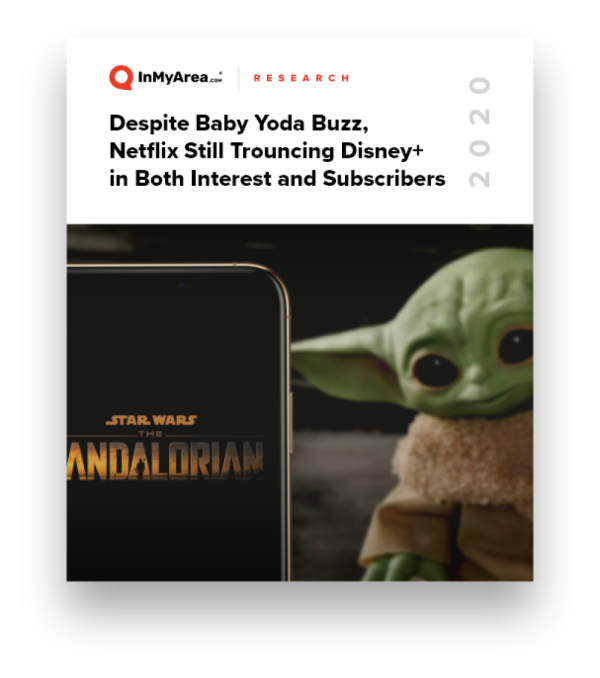Disney’s streaming service Disney+ launched November 12, 2019, with a huge catalog of Disney and Pixar family favorites, Marvel and Star Wars movies, National Geographic documentaries and The Simpsons. IMA Research showed that Disney+ had amassed 15 million subscribers within five days of launch, while Baby Yoda, the breakout star from the Disney+ Star Wars series The Mandalorian, generated a lot of buzz — and memes — for the fledgling channel also known as Disney Plus.
But among the avalanche of articles written about Disney+ (Why you can’t buy Baby Yoda toys this Christmas, Several Disney+ Movies Unexpectedly Disappear, Creator reveals Baby Yoda isn’t Yoda!), we decided to do a deeper dive on Disney Plus was the most Googled term in America this year. That is, as some would say, “fake news.” In fact, Americans have much more interest in Netflix than its junior rival with the junior Jedi.
It’s true that Google Trends listed “Disney Plus” as the top U.S. search on its Year in Search 2019, but look at how Disney Plus compared for the year in Google Trends to two other sites you may have heard of:

We can clearly see that even at its peak, searches for Disney Plus (blue) were far below those for Facebook (red) and YouTube (yellow). The bar chart on the left shows how big the difference was over the whole year. On a state-by-state basis, the Princess channel’s best performance for this match-up was in Utah, where out of every 100 searches for one of these three terms, Facebook got 53, YouTube got 45, and Disney Plus just 2. And that was in its best state!
Next, let’s look at how Disney+ and some of its streaming competition fared in Google Trends for the year:

As the blue line shows, Disney Plus barely registered for most of the year in comparison. In November, it climbed above its three rivals for a short period surrounding its launch before dropping back down. By the end of the year, it was tied with Hulu (green), while Netflix (yellow) reached new heights.
With its year-long availability, and a much larger subscriber base1 , it shouldn’t be a surprise that Netflix garnered a lot more interest — and searches — than Disney+ in 2019. Apple TV Plus (red) also launched in November, but interest never really got off the ground (IMA Research discovered that Apple’s streaming service only enjoyed 1.1 million early adopters). The bar chart on the left shows Netflix as the clear winner in 2019, followed by Hulu, Disney+, and a tiny Apple TV Plus.
So where is interest in Disney Plus high compared to these rivals? Once again, Utah led the country. Per Google Trends, for every 100 Utah searches on these four terms, 14 of them were for Disney Plus. Here’s the state-by-state breakdown:
| State | Disney Plus | Apple TV Plus | Netflix | Hulu |
|---|---|---|---|---|
| Utah | 14% | <1% | 65% | 21% |
| Idaho | 12% | <1% | 63% | 25% |
| Iowa | 11% | <1% | 64% | 25% |
| South Dakota | 11% | <1% | 62% | 27% |
| North Dakota | 11% | <1% | 61% | 28% |
| Nebraska | 11% | <1% | 62% | 27% |
| Wyoming | 10% | <1% | 63% | 27% |
| Kansas | 10% | <1% | 65% | 25% |
| Arizona | 10% | <1% | 67% | 23% |
| Minnesota | 10% | <1% | 66% | 24% |
| Kentucky | 10% | <1% | 65% | 25% |
| Michigan | 10% | <1% | 68% | 22% |
| Oklahoma | 10% | <1% | 66% | 24% |
| Missouri | 10% | <1% | 66% | 24% |
| Indiana | 10% | <1% | 65% | 25% |
| Nevada | 10% | <1% | 68% | 22% |
| Ohio | 10% | <1% | 66% | 24% |
| Tennessee | 10% | <1% | 66% | 24% |
| Montana | 9% | <1% | 66% | 25% |
| Rhode Island | 9% | <1% | 71% | 20% |
| New Hampshire | 9% | <1% | 70% | 21% |
| Washington | 9% | <1% | 70% | 21% |
| California | 9% | <1% | 72% | 19% |
| Arkansas | 9% | <1% | 66% | 25% |
| New Mexico | 9% | <1% | 69% | 22% |
| Colorado | 9% | <1% | 69% | 22% |
| Delaware | 9% | <1% | 71% | 20% |
| Hawaii | 9% | <1% | 71% | 20% |
| Mississippi | 9% | <1% | 68% | 23% |
| West Virginia | 9% | <1% | 66% | 25% |
| Virginia | 9% | <1% | 70% | 21% |
| Texas | 9% | <1% | 69% | 22% |
| Illinois | 9% | <1% | 70% | 21% |
| Alabama | 9% | <1% | 67% | 24% |
| Pennsylvania | 9% | <1% | 70% | 21% |
| Wisconsin | 9% | <1% | 66% | 25% |
| Louisiana | 9% | <1% | 68% | 23% |
| North Carolina | 9% | <1% | 68% | 23% |
| South Carolina | 9% | <1% | 67% | 24% |
| Maine | 8% | <1% | 67% | 25% |
| Oregon | 8% | <1% | 69% | 23% |
| Alaska | 8% | <1% | 67% | 25% |
| Massachusetts | 8% | <1% | 73% | 19% |
| New Jersey | 8% | <1% | 75% | 17% |
| Connecticut | 8% | <1% | 72% | 20% |
| Maryland | 8% | <1% | 73% | 19% |
| Florida | 8% | <1% | 72% | 20% |
| Georgia | 8% | <1% | 70% | 22% |
| Vermont | 7% | <1% | 71% | 22% |
| New York | 7% | <1% | 73% | 20% |
| District of Columbia | 6% | <1% | 74% | 20% |
So, for the year, Disney Plus took the bronze in every state when compared to these other streaming services, only beating out its newest rival, Apple TV Plus.
Readers might ask: if Disney+ garnered less interest than Netflix and Hulu last year, let alone Facebook and YouTube, why did it show up at the top of Google Trends Year In Search? The list is not comprised of the terms with the highest search volume, but rather those that did better when compared to 2018. As Google explains, “Lists are based on search terms that had the highest spike this year as compared to the previous year.” Since Disney didn’t even announce the name of its streaming service until November 8, 2018, it’s no wonder searches were so much higher for Disney+ in 2019.
But that didn’t stop Business Insider from proclaiming “Disney Plus was the most Googled term in America this year.” Or ABC News from stating “Across the country, the top search of the year on Google was for Disney+.” Or Inc. from writing “Disney+ was the most searched term for the entire year.” The service may be popular, but it wasn’t that popular in 2019.
And what’s become of the baby? Baby Yoda topped the Google Trends Year in Search 2019 “Babies” list, beating out “Baby Shark,” “royal baby,” “Kim Kardashian Kanye West baby” and “Cardi B baby.” IMA Research predicts there will be even more searches for “Baby Yoda” in 2020 once major merchandising drops.


